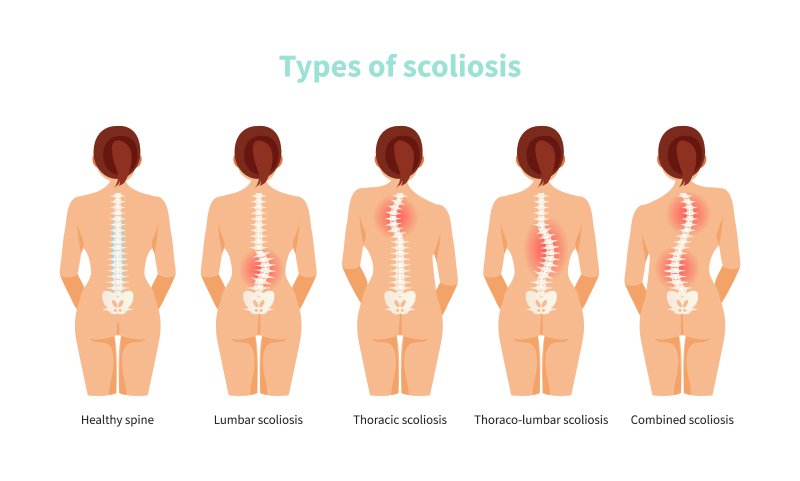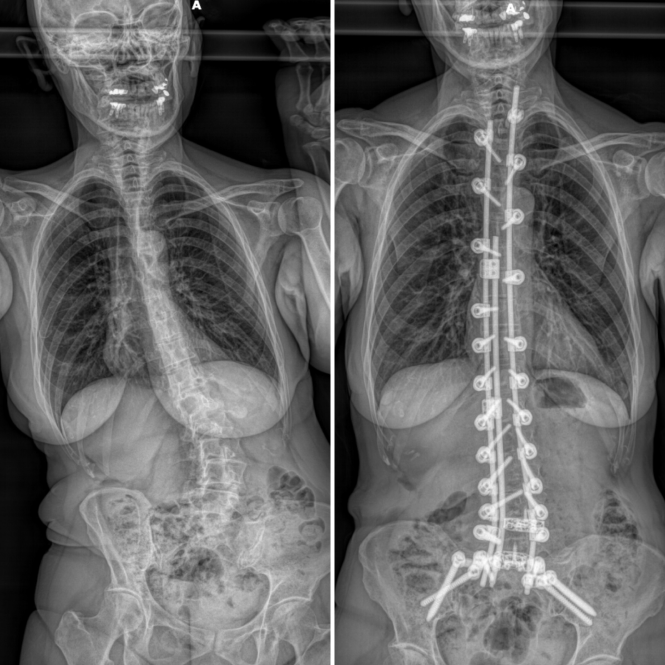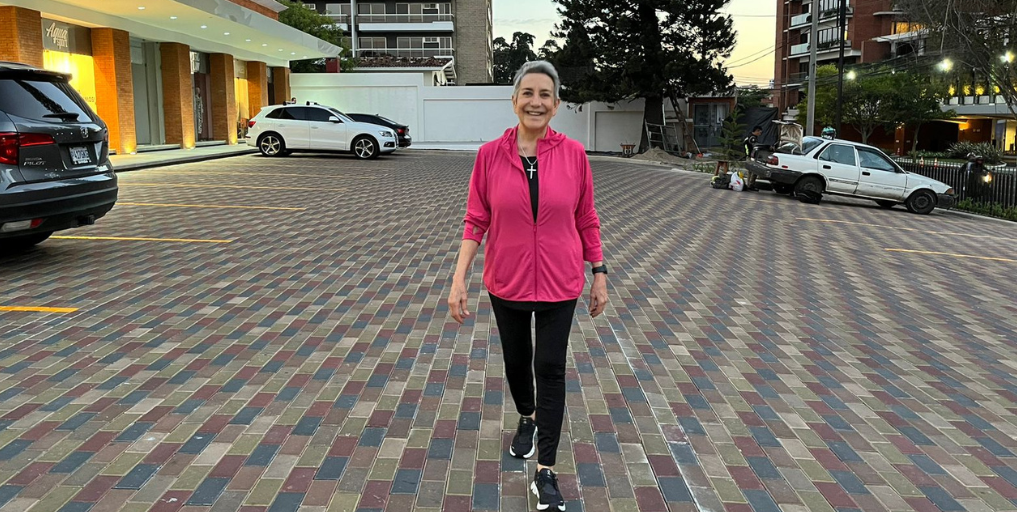Lumbar scoliosis has some specific characteristics that distinguish it from other spinal deformities. In this post, we review the symptoms, causes, and treatments for this type of scoliosis, as well as some lesser known facts about it.
Lumbar scoliosis is a deviation of the spine in the lower back, affecting the lumbar vertebrae.
This type of scoliosis has its own characteristics in terms of causes,symptoms, and treatment. At Instituto Clavel, we invite you to learn more about some of the distinguishing features of lumbar scoliosis.
1) Scoliosis has various causes
Sometimes, lumbar scoliosis appears in adults as a result of the degenerative process of ageing.
Many times, however, the cause of scoliosis cannot be determined. These cases are referred to as idiopathic scoliosis, meaning the origin is unknown.
On other occasions, the malformation of the bones of the spine is present from birth. If so, it is called congenital scoliosis.
In addition, scoliosis can also be caused by injury or certain neurological diseases. It can also be a complication resulting from prior lumbar surgery.
2) It is the most common type of scoliosis in adults
Scoliosis can affect different parts of the back.
Cervical scoliosis in the cervical spine; thoracic scoliosis in the area of the thorax, scapulae and ribs; and lumbar scoliosis in the lower back.
Thoracic scoliosis is more common in adolescence, while lumbar scoliosis is more common in adulthood, due to wear and tear on the spine. It is also possible for the abnormal curvature to affect both these areas of the spine.
In that case, it is known as thoracolumbar scoliosis.

3) The back is "C" shaped
In lumbar scoliosis, the curvature of the spine is shaped like the letter "C" in the lower back.
If it also affects the thoracic spine (the middle of the back), then it appears in the shape of an "S".

4) It can also affect the sacrum
The curvature of the spine can go beyond the lumbar region and extend into the sacrum. This is what is known as lumbosacral scoliosis.
5) Lumbar scoliosis can appear in childhood
In children, thoracic scoliosis is more common, however they can also be affected by lumbar scoliosis.
Scoliosis does not usually cause back pain in children. It is often first noticed when a curve is seen in the spine.
However, depending on the degree of scoliosis, it may not be diagnosed until puberty, when symptoms may become more apparent.
This is why it is common to diagnose scoliosis in adolescents, even if the condition was present years before.
6) It is more common in older people
Lumbar scoliosis may not appear until adulthood, and it is more common in older people.
In other words, this type of scoliosis in adults can affect people who previously had a straight spine.
In these cases, the cause is usually a degeneration of the spine or wear and tear on the spinal discs due to age.
The medical term for this is degenerative lumbar scoliosis, which can often be accompanied by other conditions such as lumbar stenosis.
Scoliosis at age 50 or older may have this origin.
Lumbar scoliosis is more common in women, although it can occur for a variety of reasons and have very different symptoms.
7) It is more common among women
Lumbar scoliosis is more common in women than in men. This is also true for other types of scoliosis.
Furthermore, women with scoliosis tend to suffer more severe cases, with the curvature of the spine exceeding 20 or 30 degrees.
Scoliosis can get worse as a woman reaches mid-life, especially with the arrival of menopause, while in men it can appear later in life.
Women become more susceptible to scoliosis, and other bone and joint problems, as they age, because they lose the protective effect that estrogens (female hormones) have on their bone health.
8) Symptoms of scoliosis can vary widely
The symptoms of lumbar scoliosis can vary greatly from person to person, and they are influenced by various factors, including the person’s age and the severity of the spinal curvature.
For this reason, adults and elderly people may find the symptoms more troublesome. Especially if they suffer from other degenerative spine diseases at the same time. For example, they may also be suffering from lumbar stenosis, osteoarthritis, or osteoporosis
Symptoms will also vary according to the degree of the spinal curvature. Mild scoliosis is not the same as severe scoliosis.
Even so, there is usually a direct relationship between scoliosis and low back pain.
Other common symptoms of lumbar scoliosis are sciatica and limping due to canal stenosis which causes pain in the legs when walking.
People with scoliosis may also have one hip or shoulder that appears higher than the other, "protruding" ribs (they appear to stick out from the rib cage), and a tilted waist.
Also, when leaning forward, one side of the spine may appear higher than the other.
However, these symptoms are more typical of adolescent scoliosis and less common in adults. They only tend to occur in the most severe cases.
People with severe scoliosis may also have difficulty breathing, swallowing, or digesting properly, although these symptoms occur very rarely.
9) In children and in mild cases, it may improve with exercise
Exercise can be very beneficial for lumbar scoliosis, as long as it is appropriately adapted exercise.
For this reason, the patient’s exercise program should be supervised by physical therapists with special knowledge of spinal pathologies.
There are various recommended exercises to relieve back pain and the other symptoms that scoliosis can cause.
In fact, physical therapy and practices like Pilates can help prevent and correct scoliosis in time.
It is equally important to know what type of physical activity or movements should be avoided. Otherwise, the activity can worsen the condition instead of improving it.
At Instituto Clavel, we have experts in physical therapy for scoliosis and other techniques at our IC Rehabilitation center.
LEARN MORE ABOUT IC REHABILITATION
10) Lumbar scoliosis can be treated
The right treatment for scoliosis depends on many factors. The important thing to keep in mind is that lumbar scoliosis can be improved and corrected.
In mild cases, conservative treatments can be used, such as keeping tabs on the condition with regular check-ups, doing exercises for scoliosis, or, in the case of children or adolescents, using an orthopedic brace.
In adults, the first treatment steps are intended to relieve symptoms and improve their quality of life. We usually do this with pain relief medications or infiltrations in the affected area.
However, sometimes these measures are not enough, and scoliosis surgery may be considered.
Instituto Clavel: Specialists in lumbar scoliosis
At Instituto Clavel we are specialists in scoliosis treatments and scoliosis surgery.
We are also the only center in Spain using the most advanced surgical technologies in this field.
This allows us to accurately predict the outcome of the scoliosis surgery before performing it. In addition, our technology allows us to design the surgical rods to custom fit the patient's spine.
If you have more questions about lumbar scoliosis, or want to make an appointment with one of our specialist doctors, please don’t hesitate to do so. At Instituto Clavel, we’re here to help!
CONTACT FORM
Categories: Spine treatments, Wellness, Lumbar pain

